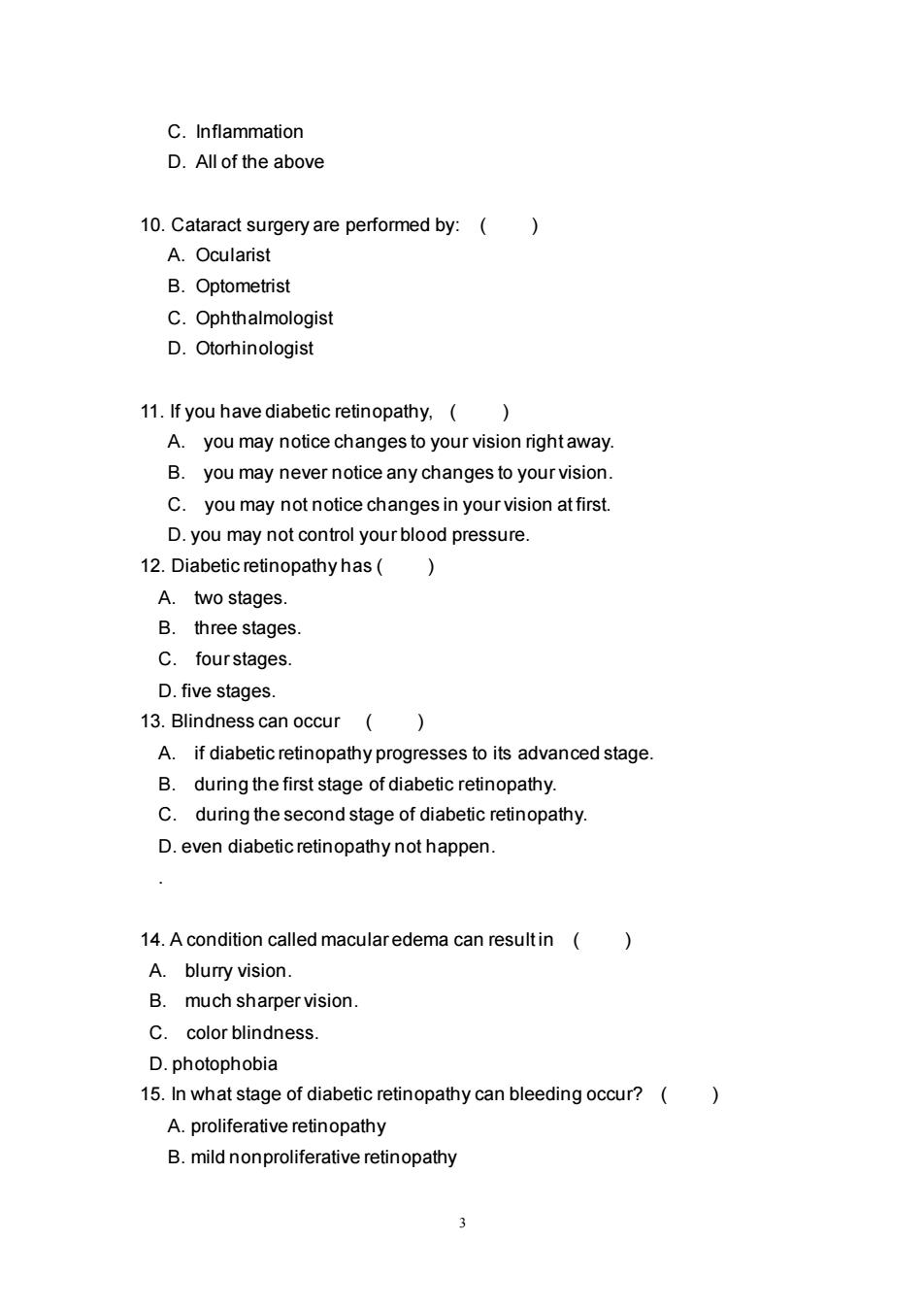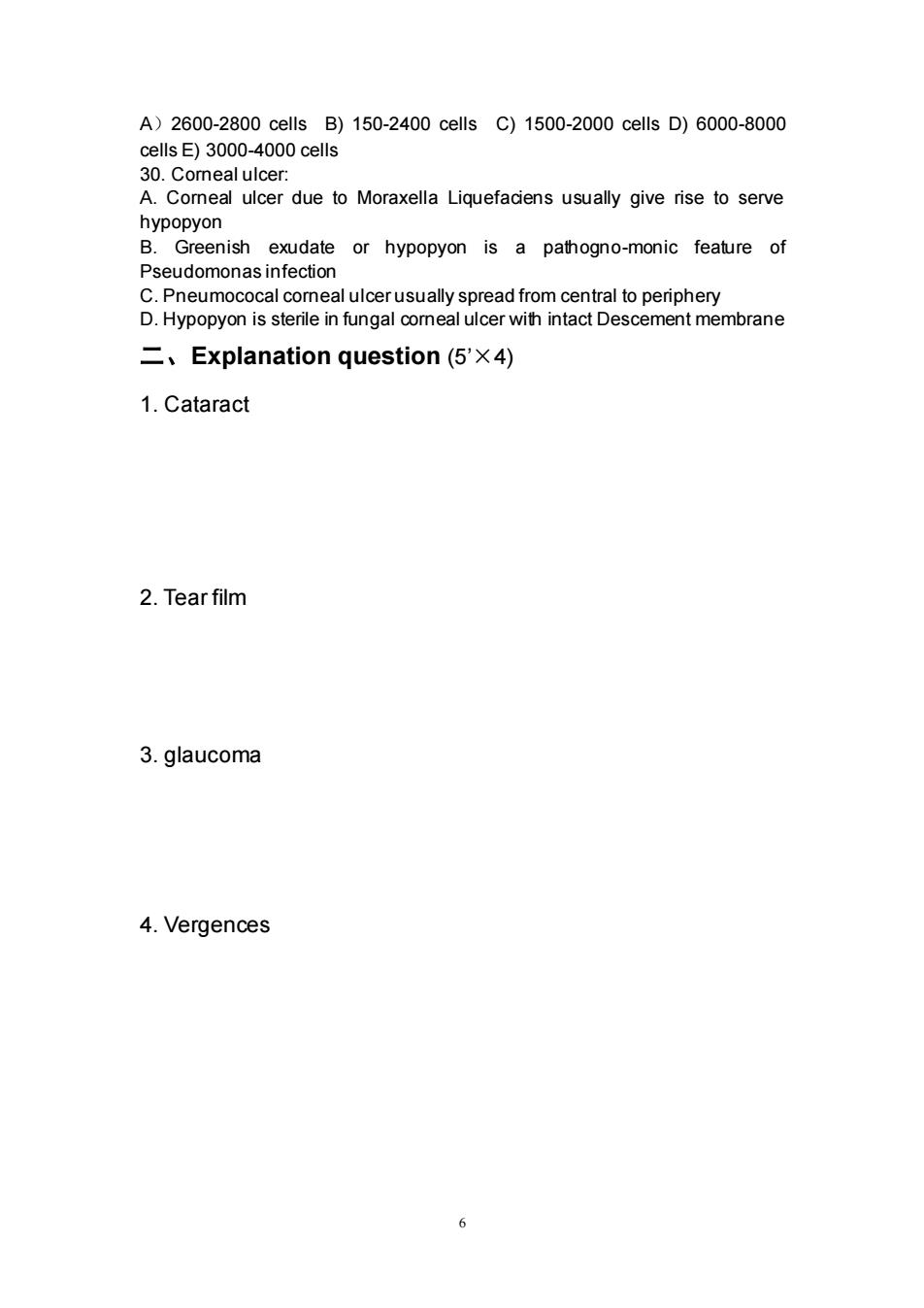
Tongji Univesity School of Medicine 2015-2016 Academic Year,the second semester Final Examination of Ophthalmology (Test paper B) Name D No Total scores Review Scores Marker -Multiple choice(Please choose the best answer)(2'x30) 1.Prostaglandin analogues lower IOP predominantly by which one of the following mechanisms?( A Increased uveoscleral outflow B Enhanced aqueous outflow by stimulation of ciliary muscle contraction C Reduced vitreous volume D Reduced aqueous production 2.Features of typical optic neuritis include ( A Yong patient B Acute monocular visual loss C Pain/discomfortwith eye movement D All of the above The manifestation of VKH syndrome are A history of headache,tinnitus,dysacusis B sunsetalow fundus or Dalen-Fuchs nodules C blurry vision and papillitis D all of the above 4.Which one is not correct for ARN syndrome? A always caused by bacteria
1 Tongji Univesity School of Medicine 2015-2016Academic Year, the second semester Final Examination of __Ophthalmology___ (Test paper B) Name ID No I II III Total scores Review Scores Marker 一、Multiple choice(Please choose the best answer)(2’×30) 1. Prostaglandin analogues lower IOP predominantly by which one of the following mechanisms? ( ) A Increased uveoscleral outflow B Enhanced aqueous outflow by stimulation of ciliary muscle contraction C Reduced vitreous volume D Reduced aqueous production 2. Features of typical optic neuritis include ( ) A Yong patient B Acute monocular visual loss C Pain/discomfort with eye movement D All of the above 3. The manifestation of VKH syndrome are ( ) A history of headache, tinnitus, dysacusis B sunset glow fundus or Dalen-Fuchs nodules C blurry vision and papillitis D all of the above 4. Which one is not correct for ARN syndrome? ( ) A always caused by bacteria

B retinal necrosis initially affecting the peripheral retina C occlusive vasculopathy D may develop a rhegmatogenous retinal detachment due to retinal atrophy 5.Which one is not the manifestation of Behcet's disease ( A headache,tinnitus B oral ulcers c genital ulcers D arthritis 6.What is modem technique of cataract surgery called? A.Trabeculectomy B.Iredectomy C.ICCE D.Phacoemulsification 7.Intraocularlenses that can correct astigmatism or cylindrical number are called: A.Toric IOL B.Multifocal IOL C.Astigmatic IOL D.Monofocal IOL 8.In which of the following are glasses required for near vision after cataract surgery?() A.Multifocal IOL B.Accomodative IOL C.Monovision IOL for distance correction D.Monovision IOL for near correction 9.What is the most common cause of reduced vision after cataract surgery? A.After cataract B.Refractive error
2 B retinal necrosis initially affecting the peripheral retina C occlusive vasculopathy D may develop a rhegmatogenous retinal detachment due to retinal atrophy 5. Which one is not the manifestation of Behçet’s disease ( ) A headache, tinnitus B oral ulcers C genital ulcers D arthritis 6. What is modern technique of cataract surgery called? ( ) A. Trabeculectomy B. Iredectomy C. ICCE D. Phacoemulsification 7. Intraocular lenses that can correct astigmatism or cylindrical number are called: ( ) A. Toric IOL B. Multifocal IOL C. Astigmatic IOL D. Monofocal IOL 8. In which of the following are glasses required for near vision after cataract surgery ? ( ) A. Multifocal IOL B. Accomodative IOL C. Monovision IOL for distance correction D. Monovision IOL for near correction 9. What is the most common cause of reduced vision after cataract surgery? ( ) A. After cataract B. Refractive error

C.Inflammation D.All of the above 10.Cataract surgery are performed by:( A.Ocularist B.Optometrist C.Ophthalmologist D.Otorhinologist 11.If you have diabetic retinopathy, A.you may notice changes to your vision right away. B you may never notice any changes to your vision C.you may not notice changes in yourvision atfirst D.you may not control your blood pressure. 12.Diabetic retinopathy has( A.two stages. B.three stages C.fourstages. D.five stages. 13.Blindness can occur ( A.if diabetic retinopathy progresses to its advanced stage. B. during the first stage of diabetic retinopathy. C.during the second stage of diabetic retinopathy D.even diabetic retinopathy not happen. 14.A condition called macularedema can resultin A.blurry vision B.much sharper vision C.color blindness D.photophobia 15.In what stage of diabetic retinopathy can bleeding occur? A.proliferative retinopathy B.mild nonproliferative retinopathy
3 C. Inflammation D. All of the above 10. Cataract surgery are performed by: ( ) A. Ocularist B. Optometrist C. Ophthalmologist D. Otorhinologist 11. If you have diabetic retinopathy, ( ) A. you may notice changes to your vision right away. B. you may never notice any changes to your vision. C. you may not notice changes in your vision at first. D. you may not control your blood pressure. 12. Diabetic retinopathy has ( ) A. two stages. B. three stages. C. four stages. D. five stages. 13. Blindness can occur ( ) A. if diabetic retinopathy progresses to its advanced stage. B. during the first stage of diabetic retinopathy. C. during the second stage of diabetic retinopathy. D. even diabetic retinopathy not happen. . 14. A condition called macular edema can result in ( ) A. blurry vision. B. much sharper vision. C. color blindness. D. photophobia 15. In what stage of diabetic retinopathy can bleeding occur? ( ) A. proliferative retinopathy B. mild nonproliferative retinopathy

C.moderate nonproliferative retinopathy D.severe nonproliferative retinopathy 16.Early signs of diabetic retinopathy include all of the following except A.leaking blood vessels and any vision changes. B.retinal swelling or macularedema. C.pale,fatty deposits on the retina--signs of leaking blood vessels. D.inability to keep eyes open. 17.To prevent progression of diabetic retinopathy,people with diabetes should control their levels of A.blood sugar B.blood pressure C.blood cholesterol. D.all of the above 18.People with which type of retinopathy can reduce their risk of blindness with treatment and follow-up care?( A.moderate nonproliferative retinopathy B.proliferative retinopathy C.severe nonproliferative retinopathy D.mild nonproliferative retinopathy 19.For the classification of ocular muscles,which pair below is NOT agonist-antagonist pair? A.Superior oblique vs.inferior oblique B.Superior rectus vs.inferior oblique C.Medial rectus vs.lateral rectus D.Superior rectus vs.inferior rectus 20.The most common type of senile cataract is A.cortical cataract B.nuclear cataract C.posterior capsular cataract D.none 21.Diabetes causes
4 C. moderate nonproliferative retinopathy D. severe nonproliferative retinopathy 16. Early signs of diabetic retinopathy include all of the following except ( ) A. leaking blood vessels and any vision changes. B. retinal swelling or macular edema. C. pale, fatty deposits on the retina -- signs of leaking blood vessels. D. inability to keep eyes open. 17. To prevent progression of diabetic retinopathy, people with diabetes should control their levels of ( ) A. blood sugar. B. blood pressure. C. blood cholesterol. D. all of the above 18. People with which type of retinopathy can reduce their risk of blindness with treatment and follow-up care? ( ) A. moderate nonproliferative retinopathy B. proliferative retinopathy C. severe nonproliferative retinopathy D. mild nonproliferative retinopathy 19. For the classification of ocular muscles, which pair below is NOT agonist-antagonist pair? ( ) A. Superior oblique vs. inferior oblique B. Superior rectus vs. inferior oblique C. Medial rectus vs. lateral rectus D. Superior rectus vs. inferior rectus 20. The most common type of senile cataract is A. cortical cataract B. nuclear cataract C. posterior capsular cataract D. none 21. Diabetes causes

A.metabolic cataract B.complicated cataract C.senile cataract D.congenital cataract 22.The lens nutrition mainly from A.aqueous and choroid B.aqueous and vitreous body C.aqueous and iris D. retina and aqueous 23.All of the following are well established early signs of glaucomatous damage EXCEP下 A)Vertical elongation of the cup B)Peripapillary atrohy C)Splinterhemorrhage on disc D)Nerve fiber layer loss 24.What are the signs of cataract? A.Blurring of vision B.Double vision in one eye C.Halos around light D.All of the above 25.When should one undergo cataract surgery? A.Wait for it to mature B.When there is difficulty in vision C.All of the above D.None of the above 26.What causes cataract? A.Excessive reading B.Keeping eyes closed C.Ultraviolet lightexposure D.None of the above 27.Which of these eye diseases used to be untreatable? A.Glaucoma B.Cataracts C.Most cases of macular degeneration D.Diabetic retinopathy 28.When eyelid bruising and swelling was obvious,how long should be in the A)24 hours B)72 hou C)12 hours D)48 hours E)36 hours 29.How many endothelial cells in normal comeal of 30-year-old man?
5 A. metabolic cataract B. complicated cataract C. senile cataract D. congenital cataract 22.The lens nutrition mainly from A. aqueous and choroid B. aqueous and vitreous body C. aqueous and iris D. retina and aqueous 23. All of the following are well established early signs of glaucomatous damage EXCEPT: A) Vertical elongation of the cup B) Peripapillary atrohy C) Splinter hemorrhage on disc D) Nerve fiber layer loss 24. What are the signs of cataract? A. Blurring of vision B. Double vision in one eye C. Halos around light D. All of the above 25. When should one undergo cataract surgery? A. Wait for it to mature B. When there is difficulty in vision C. All of the above D. None of the above 26. What causes cataract? A. Excessive reading B. Keeping eyes closed C. Ultraviolet light exposure D. None of the above 27. Which of these eye diseases used to be untreatable? A. Glaucoma B. Cataracts C. Most cases of macular degeneration D. Diabetic retinopathy 28. When eyelid bruising and swelling was obvious, how long should be in the cold compress after the injury? A)24 hours B)72 hours C)12 hours D)48 hours E)36 hours 29. How many endothelial cells in normal corneal of 30-year- old man?

A)2600-2800 cells B)150-2400 cells C)1500-2000 cells D)6000-8000 cells E)300-000 cells 30.Comeal ulcer: A.Comeal ulcer due to Moraxella Liquefaciens usually give nise to serve hypopyon B.Greenish exudate or hypopyon is a pathogno-monic feature of Pseudomonas i C.Pneumococal comeal ulcerusually spread from central to periphery D.Hypopyon is sterile in fungal comeal ulcer with intact Descement membrane 二、Explanation question(5'×4) 1.Cataract 2.Tear film 3.glaucoma 4.Vergences 6
6 A)2600-2800 cells B) 150-2400 cells C) 1500-2000 cells D) 6000-8000 cells E) 3000-4000 cells 30. Corneal ulcer: A. Corneal ulcer due to Moraxella Liquefaciens usually give rise to serve hypopyon B. Greenish exudate or hypopyon is a pathogno-monic feature of Pseudomonas infection C. Pneumococal corneal ulcer usually spread from central to periphery D. Hypopyon is sterile in fungal corneal ulcer with intact Descement membrane 二、Explanation question (5’×4) 1. Cataract 2. Tear film 3. glaucoma 4. Vergences

三、Essay question 1.What is the symptoms and signs of acute angle closure?(10)
7 三、Essay question 1. What is the symptoms and signs of acute angle closure? (10’)

2.Diagnosis and treatment of bacterial keratitis.(10')
8 2. Diagnosis and treatment of bacterial keratitis. (10’)